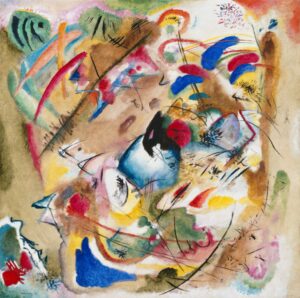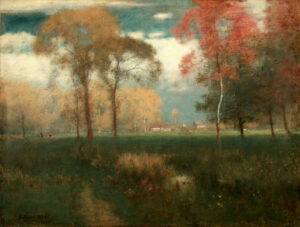
Introduction: Who Was Wassily Kandinsky?
Wassily Kandinsky (1866-1944) is recognized as one of the most influential painters of the twentieth century and the pioneer of modern abstract art. A Russian artist who became a naturalized German and later French citizen, Kandinsky revolutionized painting by liberating colour and form from any obligation of figurative representation, thereby paving the way for abstract expressionism and modern art.
Biography: From Muscovite Origins to Artistic Vocation
Childhood in Moscow and Odessa (1866-1885)
Born on 4 December 1866 in Moscow into a prosperous family, Wassily Kandinsky grew up in a culturally rich environment. His father, descended from a family enriched through the tea and fur trade, and his mother, from Moscow’s nobility, transmitted to him their passion for the arts. From his earliest years, the child was initiated into drawing, music, and foreign languages.
In 1871, the family moved to Odessa for reasons of paternal health. It was there that Kandinsky spent his childhood, under the tutelage of his maternal aunt Elisabeth Ivanovna following his parents’ separation. He studied piano from the age of eight and took up the violoncello, whilst cultivating his primary passion for drawing.
University Education and Legal Career (1885-1896)
Kandinsky enrolled at Moscow University in 1885 to study law. He specialized in political economy and obtained his degree in 1892, becoming a professor of jurisprudence. In 1889, an ethnographic mission to the Vologda region brought him into contact with Russian popular art, an experience that would profoundly mark his artistic sensibility.
The Decisive Turn Towards Art
Two major events in 1895 transformed Kandinsky’s trajectory: the exhibition of the Impressionists in Moscow and the performance of Wagner’s opera Lohengrin. Before Monet’s Haystacks, he discovered that a painting could move the viewer independently of its recognizable subject. This revelation, combined with the synaesthetic effect provoked by the Wagnerian opera, led him to refuse a professorial chair at the University of Tartu in 1896 to devote himself entirely to painting.
Artistic Training in Munich (1896-1911)
Apprenticeship and First Teaching
At thirty years of age, Kandinsky settled in Munich where he studied at the Ažbe drawing school, then at the Academy of Fine Arts under Franz von Stuck, who criticized his “extravagances of colour.” From 1901, he founded the Phalanx group where he taught. It was there that he met Gabriele Münter, who became his companion until the First World War.
Evolution Towards Abstraction
The works from this period, such as The Blue Rider (1903) and Sunday, Old Russia (1904), demonstrate an increasingly free use of colour. Between 1902 and 1907, Kandinsky created “coloured drawings” imbued with nostalgia, evoking Old Russia and medieval Germany.
The Blue Mountain (1908-1909) marks a turning point towards pure abstraction, with colours applied independently of forms. From 1909 onwards, what he termed the “choir of colours” became increasingly brilliant, charged with cosmic and emotive significance.
Der Blaue Reiter and the Birth of Abstraction (1911-1914)
Theory and Practice of Abstract Art
In 1911, Kandinsky founded the group Der Blaue Reiter (The Blue Rider) with Franz Marc and other artists sharing his radical vision of art. That same year, his seminal work Concerning the Spiritual in Art was published, in which he expounded his theory of the psychological effect of colours on the human soul and their “inner sound.”
Synaesthesia and Musical Influence
Music played a central role in Kandinsky’s conception of abstract art. Presenting a form of synaesthesia associating colours, forms, and sounds, he named his spontaneous works “improvisations” and his elaborate compositions “compositions,” in direct reference to musical terminology. His friendship with the composer Arnold Schoenberg, pioneer of atonal music, reinforced this approach.
With the Black Arc (1912): Manifesto of Abstraction
This emblematic work of 1912 represents one of the first total abstractions in art history. It depicts nothing other than forms and colours liberated from all representation of the real world, seeking to provoke emotions and sentiments through the interplay of composition and chromatic harmonies.
Russian Period and Political Engagement (1914-1921)
The First World War brought Kandinsky back to Russia via Switzerland and Sweden. Between 1918 and 1921, he participated actively in the development of Soviet cultural policy, collaborating on museum reform and artistic pedagogy. He organized the Institute of Artistic Culture in Moscow with a programme based on the analysis of forms and colours.
In 1916, he met Nina Andreievskaya, who became his wife the following year. This period saw little pictorial production due to his administrative commitments. In 1921, the architect Walter Gropius invited him to the Bauhaus in Weimar. The following year, Soviet authorities banned abstract art, deeming it incompatible with socialist ideals.
The Bauhaus Period (1922-1933)
Teaching and Theorization
At the Bauhaus, a revolutionary school fusing plastic arts and applied arts, Kandinsky was reunited with Paul Klee and Josef Albers, former fellow students under von Stuck. He taught in the mural painting workshop, developing his theory of colours and the psychology of form. These researches culminated in the publication of Point and Line to Plane in 1926, his second major theoretical work.
Geometric Evolution
Geometric elements—circles, semi-circles, angles, straight and curved lines—assumed increasing importance in his work. This period of intense production distinguished itself from Constructivism and Suprematism through the freedom of surface treatment and richness of colours.
Yellow-Red-Blue (1925): Chromatic Symphony
This monumental work, two metres wide, transposes Goethe’s Theory of Colours, illustrating the birth of red through the encounter of yellow (light) and blue (darkness). A yellow vertical rectangle, an inclined red cross, and a large dark blue circle compose a visual symphony of delicate complexity.
Closure of the Bauhaus
Faced with Nazi hostility, the Bauhaus moved from Weimar to Dessau in 1925, then closed definitively in 1933 following a defamatory campaign. Kandinsky left Germany for Paris, where he exhibited at the Salon des Surindépendants in October-November 1933.
The Great Parisian Synthesis (1934-1944)
Isolation and Renewal
In Paris, Kandinsky found himself relatively isolated in an artistic context dominated by Cubism and Art Deco, unfavourable to geometric abstraction. Installed in a small flat in Neuilly-sur-Seine transformed into a studio, he developed a new pictorial language.
Biomorphic Forms and Technical Innovations
Biomorphic forms with supple contours, evoking microscopic organisms, appeared in his work. He experimented with unprecedented colour compositions inspired by Slavic popular art, creating precious filigree works. The use of sand mixed with pigments gave his paintings an innovative granular texture.
Compositions IX and X: Pictorial Testaments
This period constitutes a vast synthesis of his earlier work. Composition IX (1936) presents powerful contrasted diagonals whose central form evokes a human embryo. Composition X (1939) deploys small coloured squares and bands detaching themselves from a black ground like stellar fragments, whilst enigmatic pastel hieroglyphs cover a floating brown mass.
Kandinsky’s Legacy and Influence
Fundamental Theoretical Contributions
Kandinsky bequeathed two major theoretical works that continue to influence artists and theorists: Concerning the Spiritual in Art (1911) explores the spiritual mission of art and the psychological effect of colours, whilst Point and Line to Plane (1926) systematically analyses the fundamental elements of pictorial composition.
Pioneer of Abstraction
Although certain historians debate the backdating of his first abstract watercolour, Kandinsky’s essential contribution remains his progressive and theorized rejection of all figurative elements, opening the way for abstract expressionism and all forms of non-figurative art of the twentieth century.
Death and Posterity
Kandinsky acquired French nationality in 1939 and died in Neuilly-sur-Seine on 13 December 1944, at the age of 78. He is interred in the new cemetery of Neuilly-sur-Seine alongside his wife Nina, leaving an abundant body of work that continues to inspire generations of contemporary artists.
Conclusion: Kandinsky’s Contemporary Relevance
The work of Wassily Kandinsky remains of burning relevance for understanding the evolution of modern art towards abstraction. His conception of painting as an autonomous language, capable of directly expressing inner life without recourse to the representation of the visible world, revolutionized our understanding of what art can be. Painter, theorist, and pedagogue, Kandinsky embodies the figure of the total artist, whose legacy continues to nourish contemporary aesthetic debates on the role and function of art in society.
Artworks and biography of Wassily Kandinsky
- Wassily Kandinsky: Pioneer of Abstract Art and Theorist of Colour
- Wassily Kandinsky: Railway near Murnau
- Wassily Kandinsky: Munich – Outside the city
- Wassily Kandinsky: Improvisation 26 (Rowing)
- Kandinsky: Improvisation No. 30 (Cannons)
V






